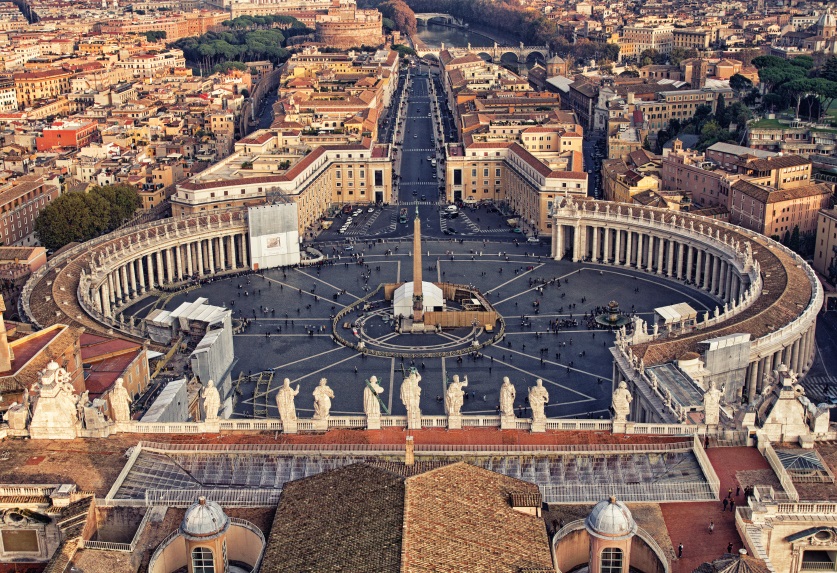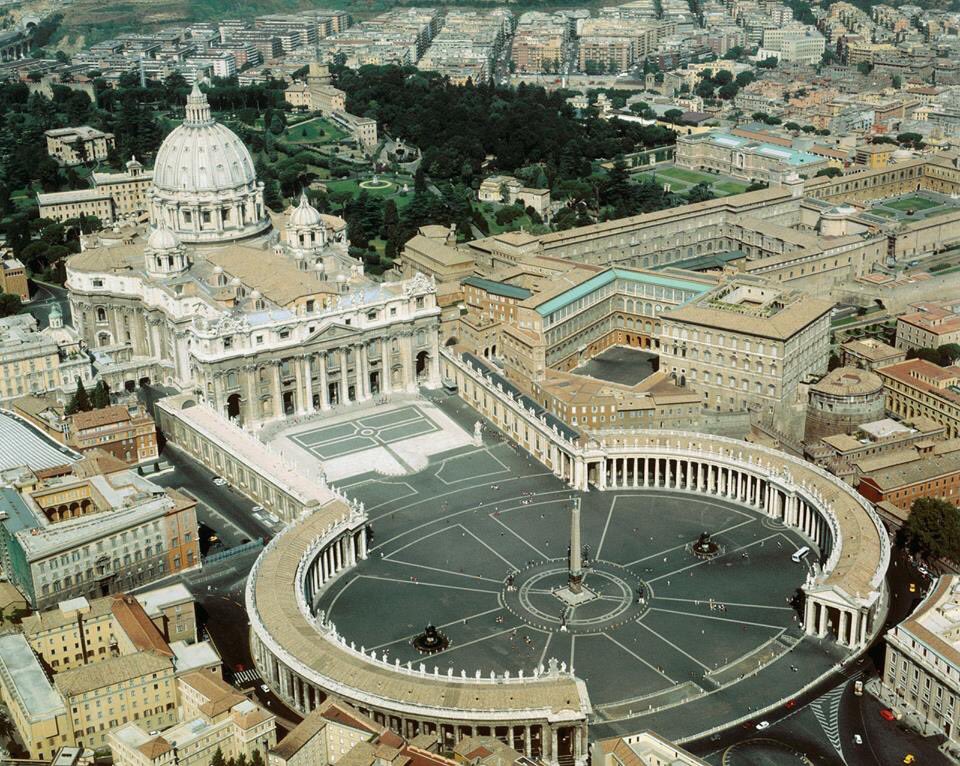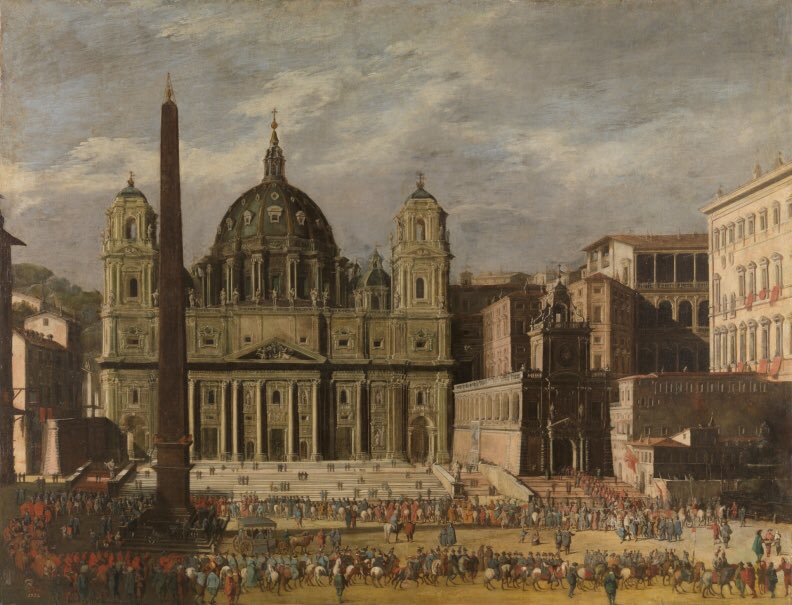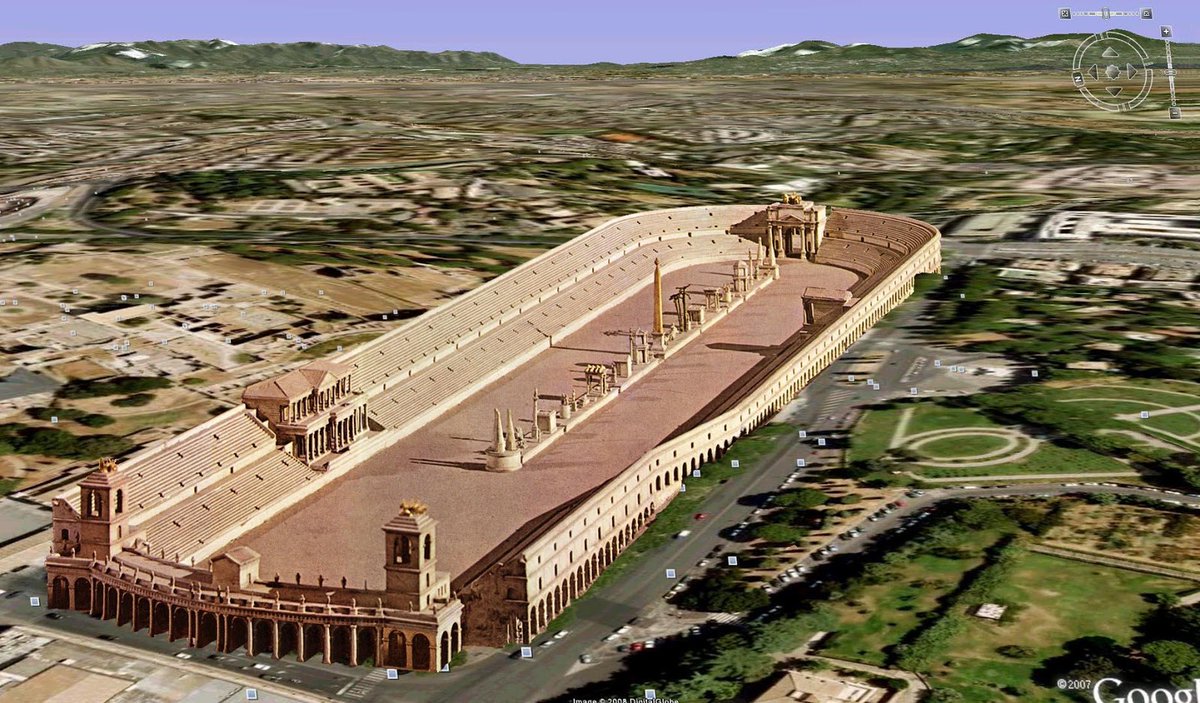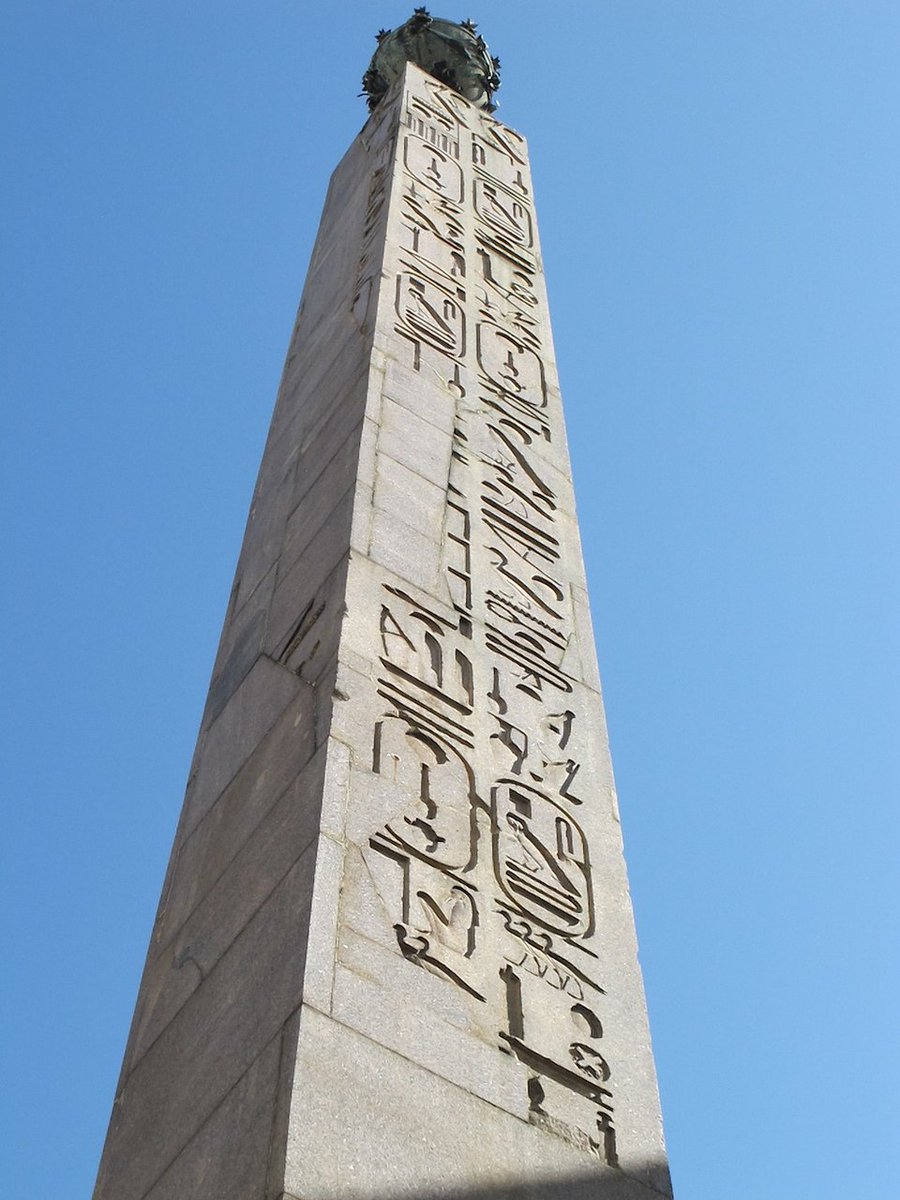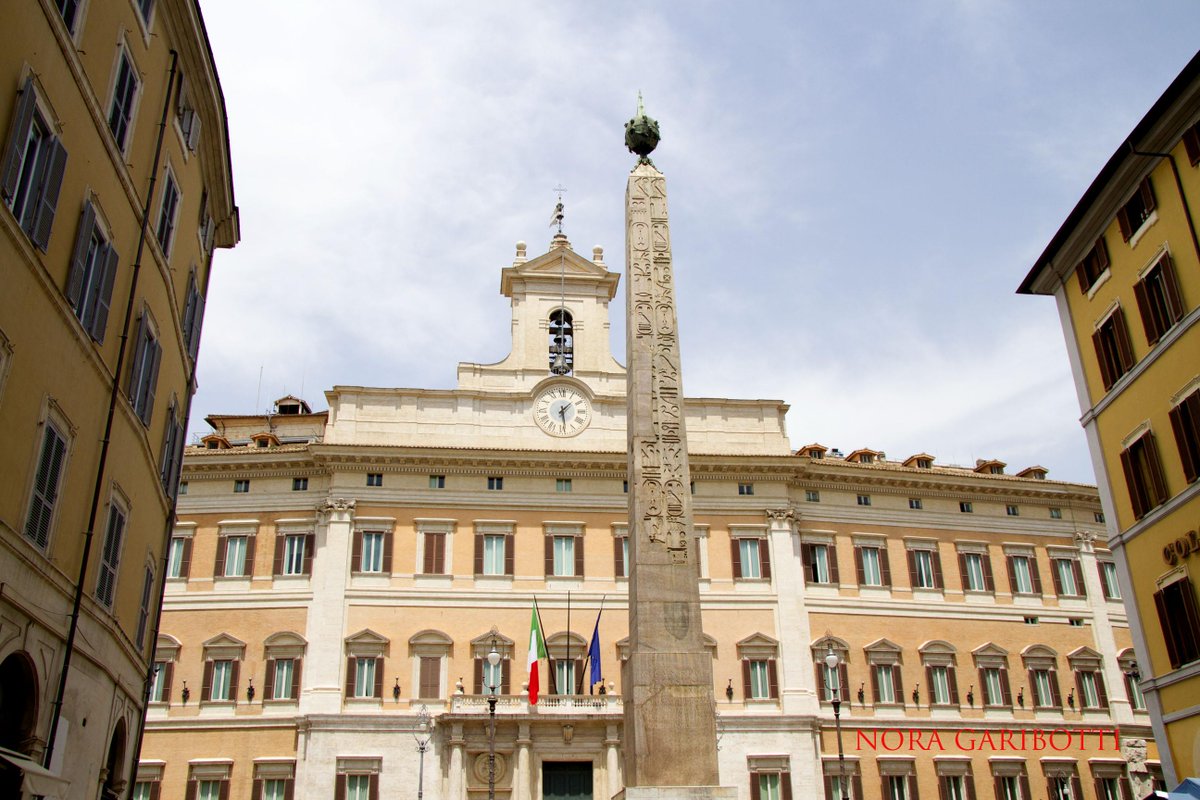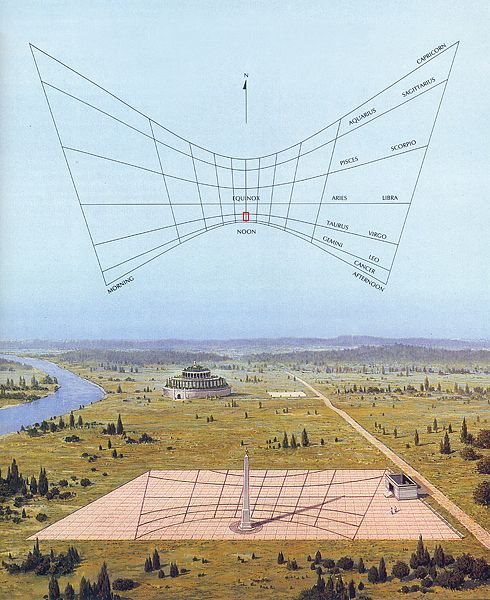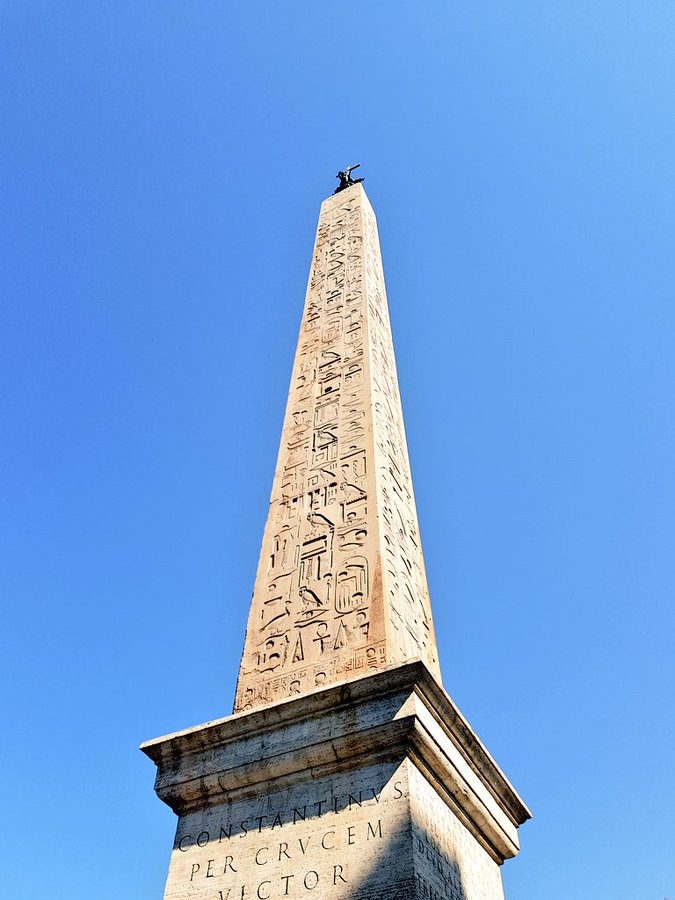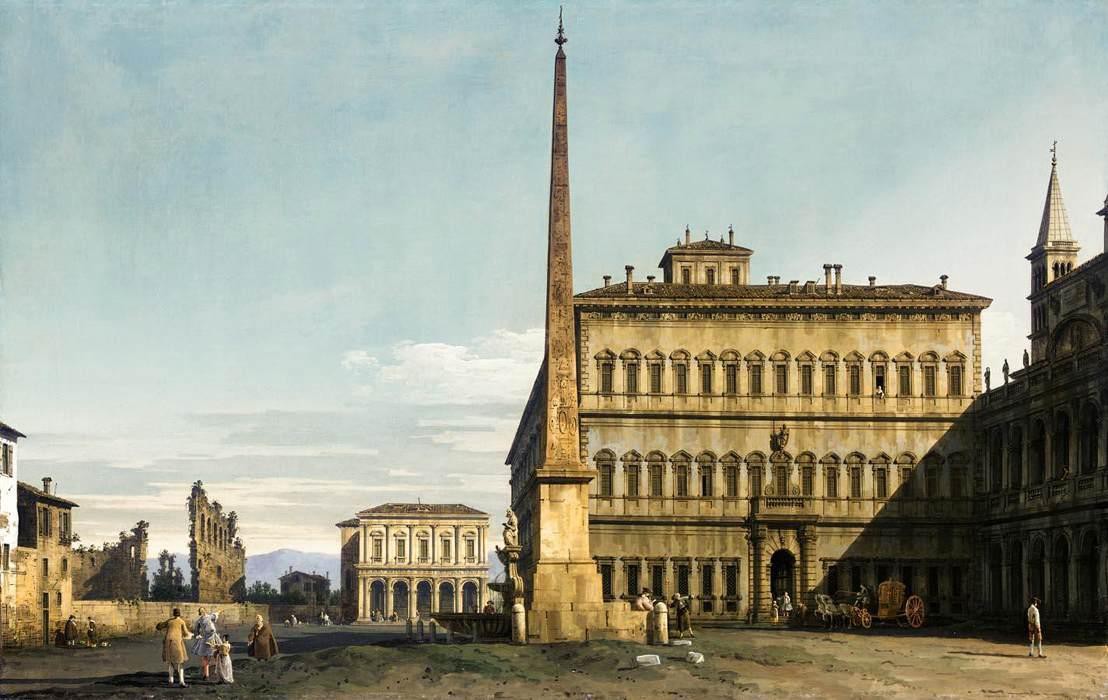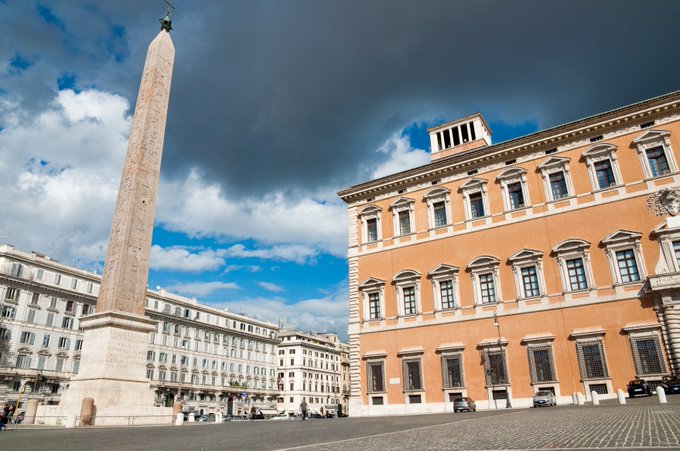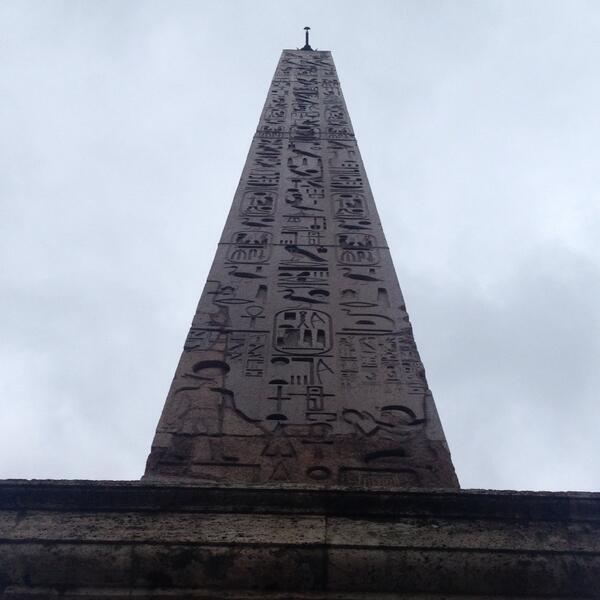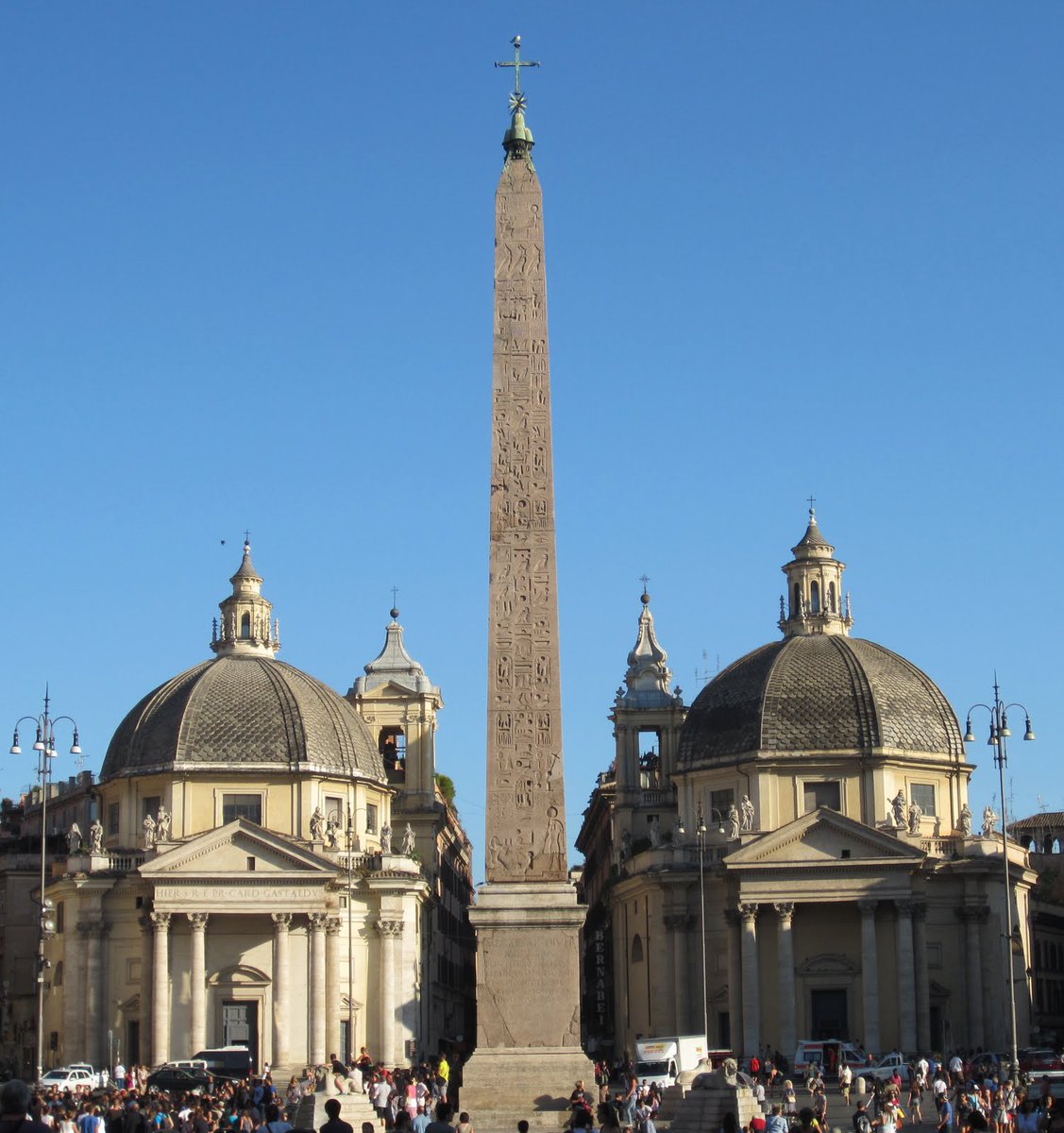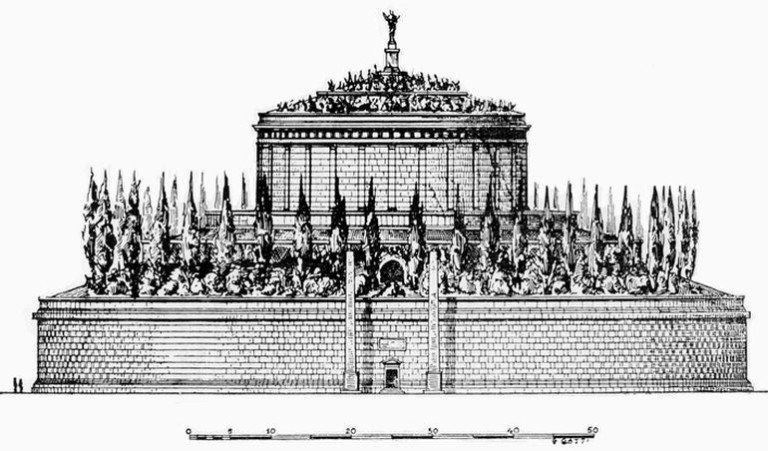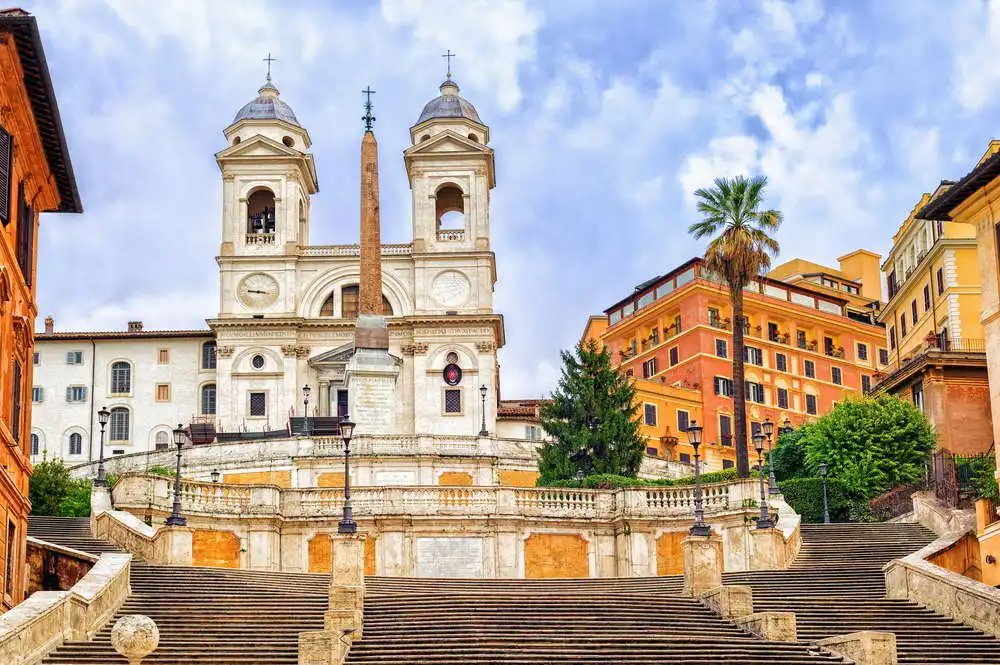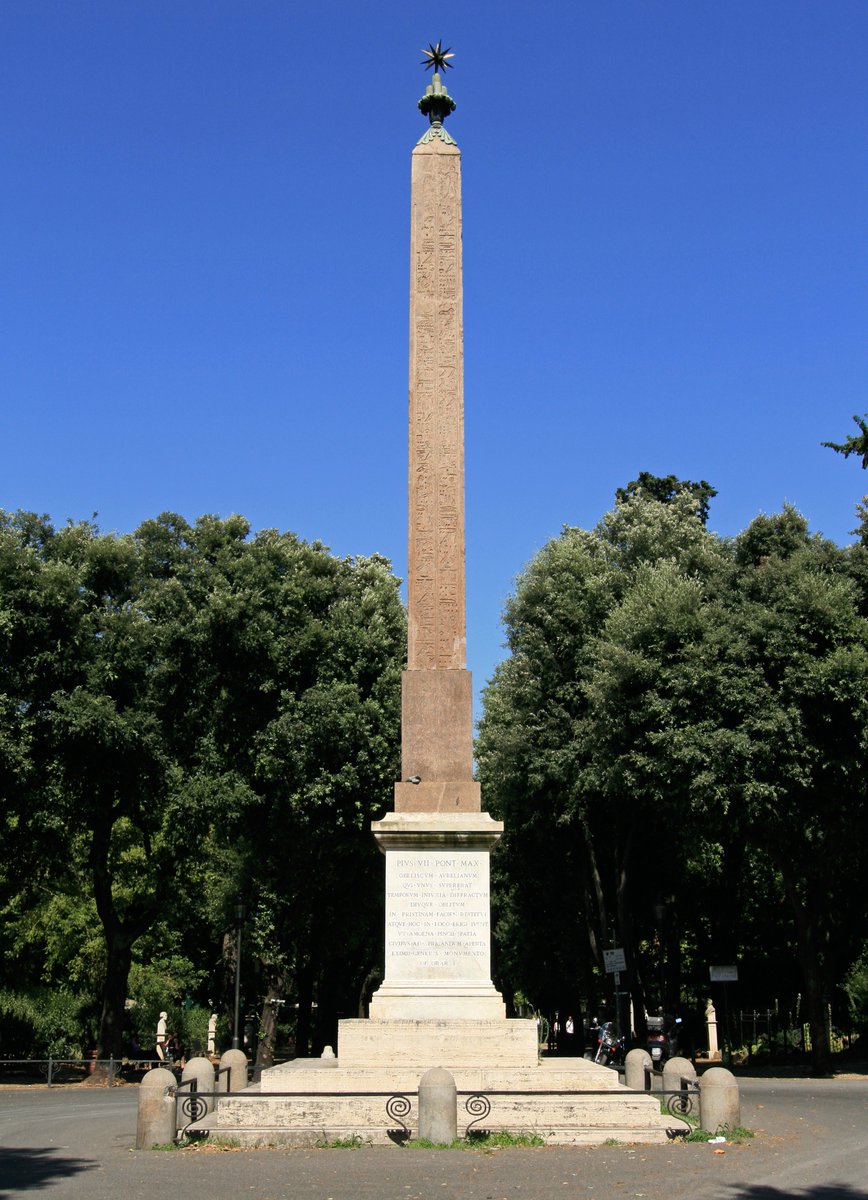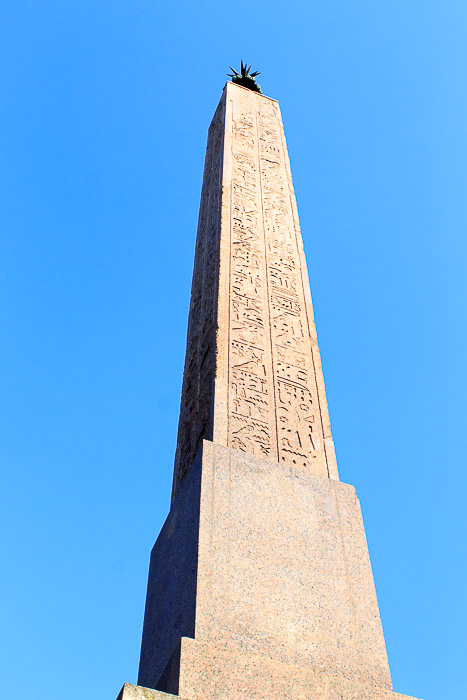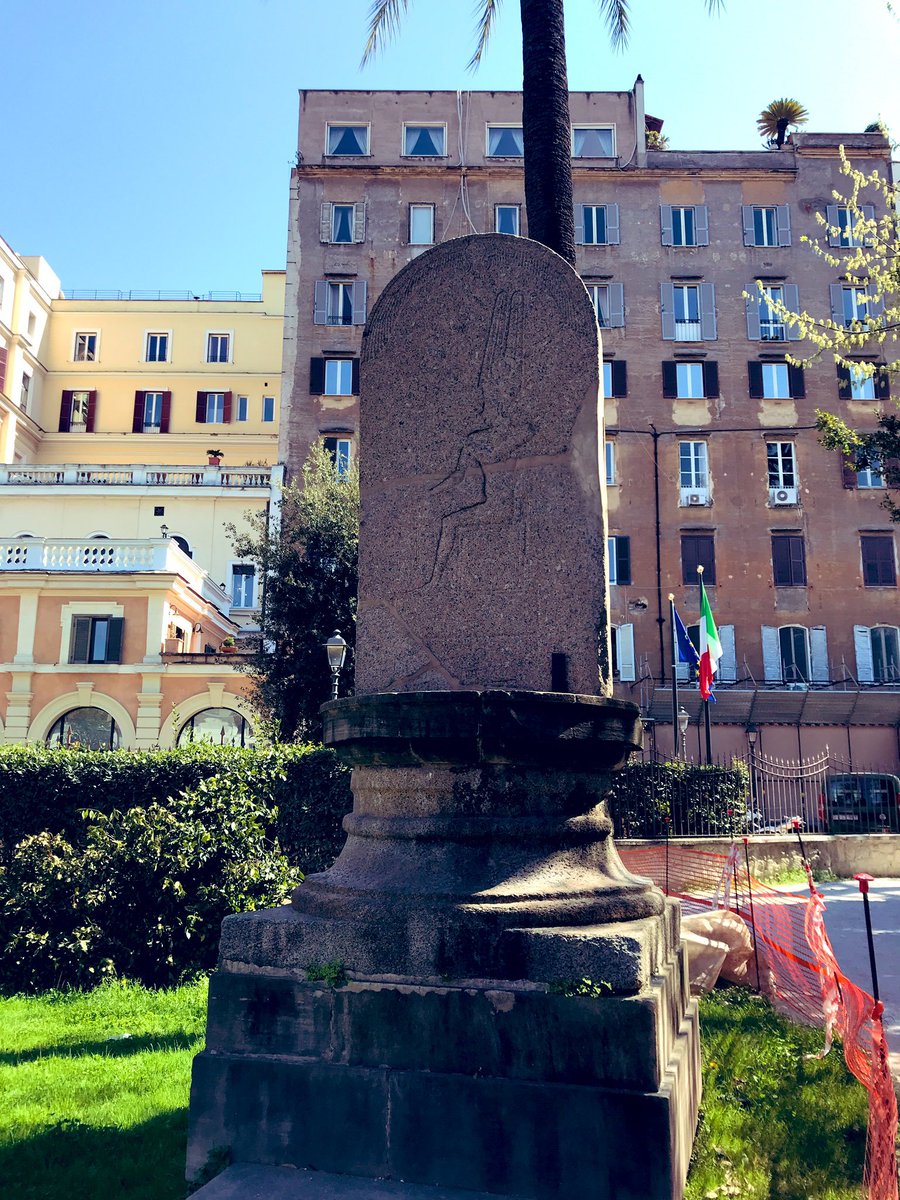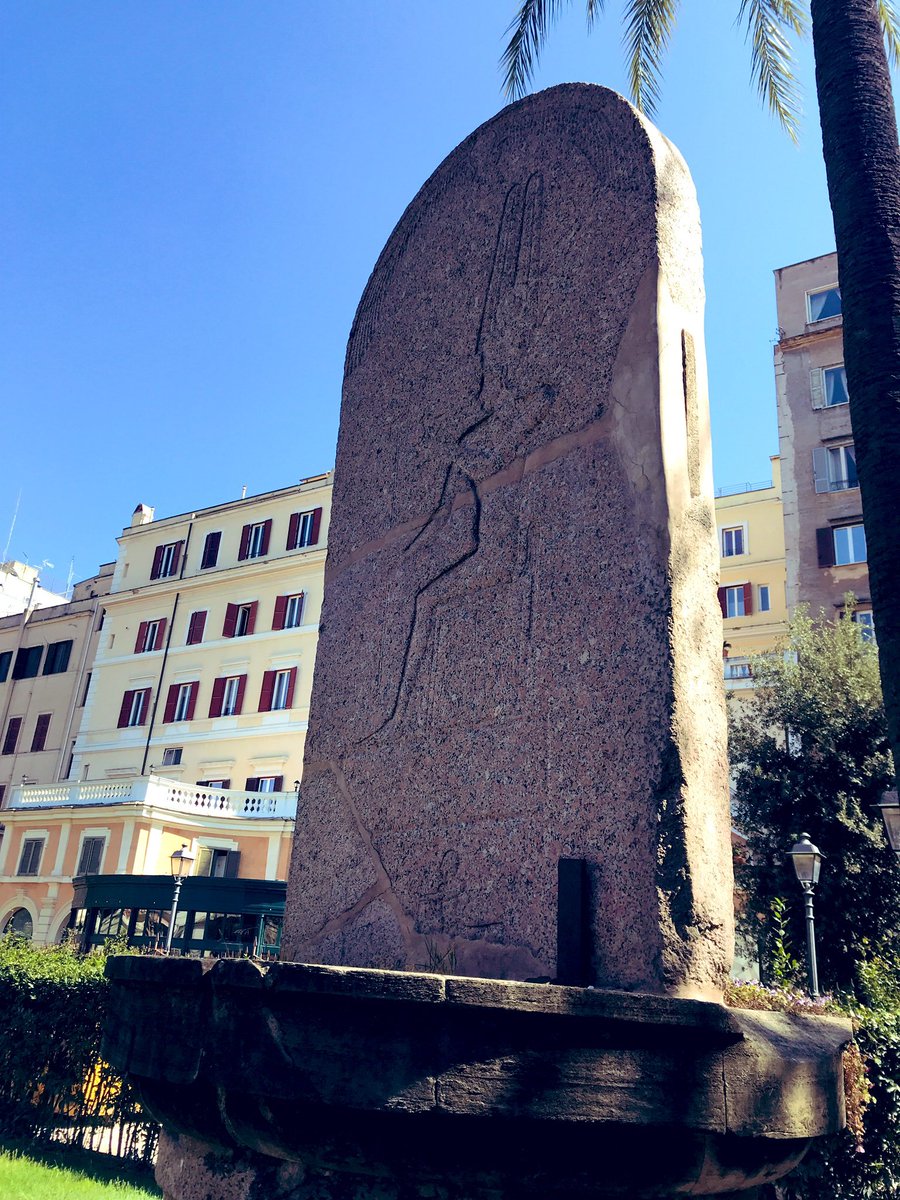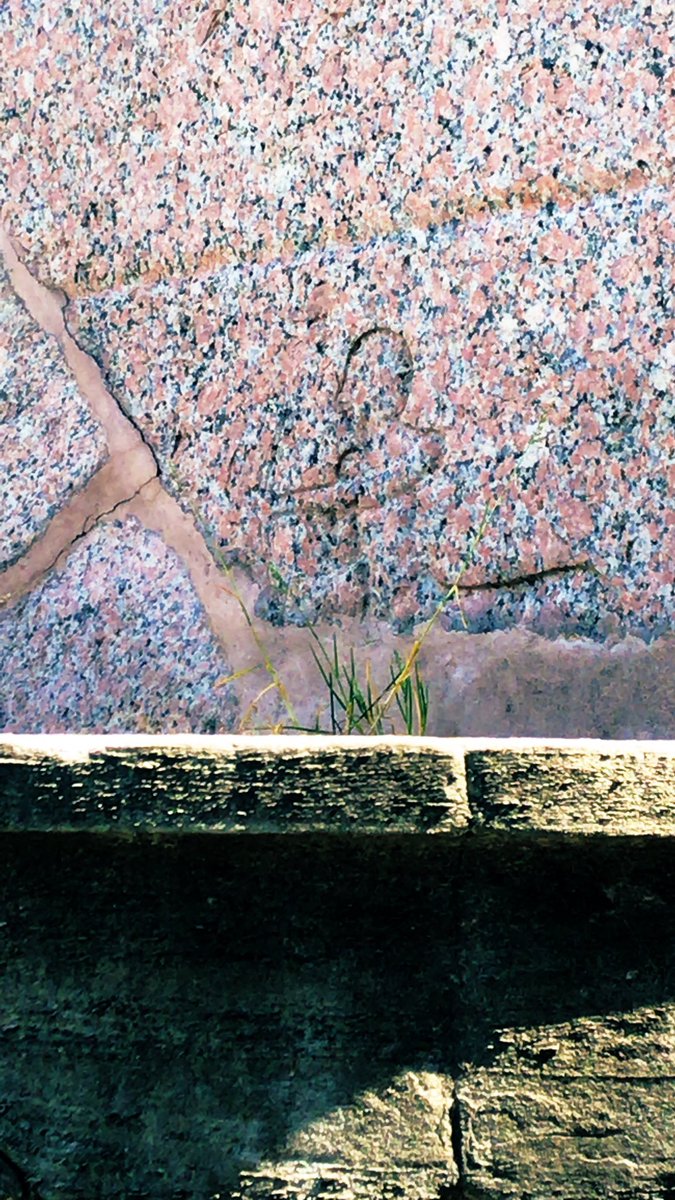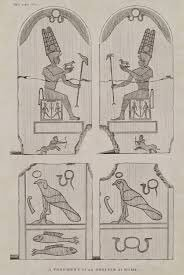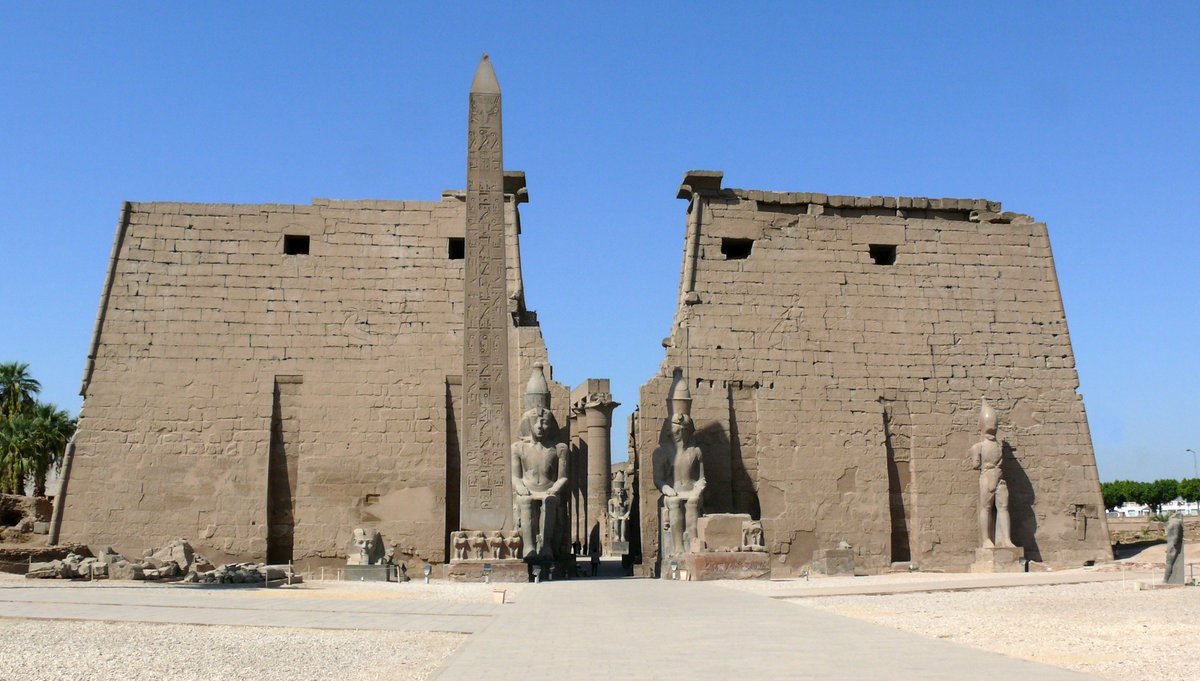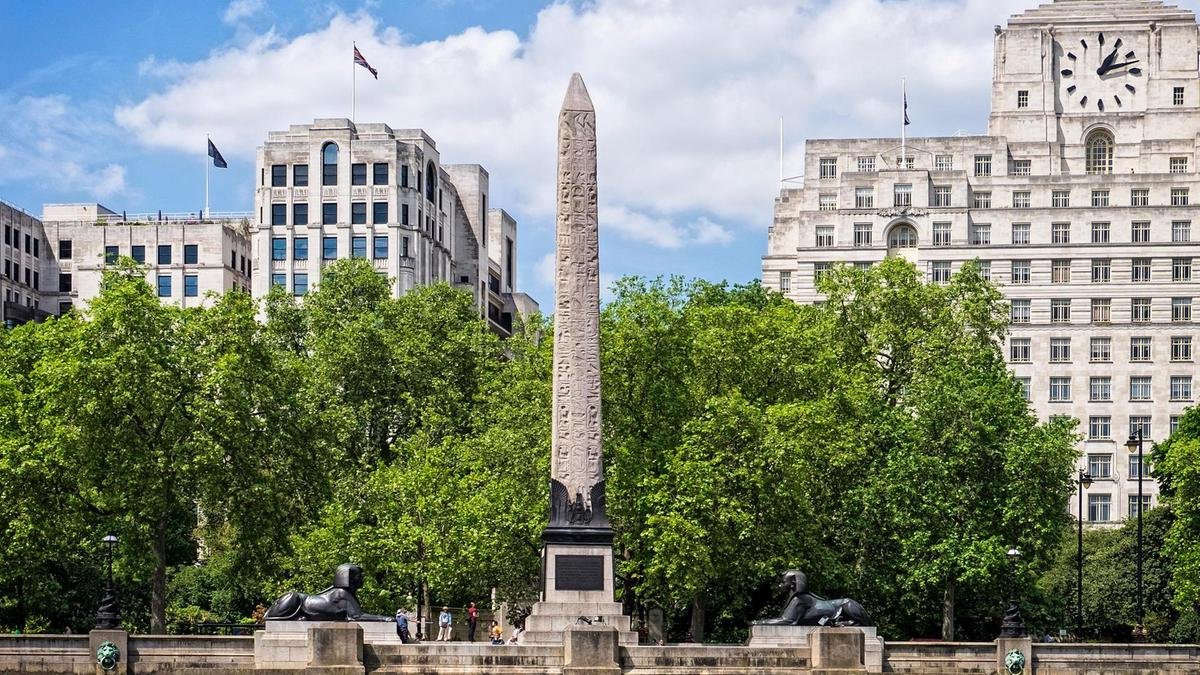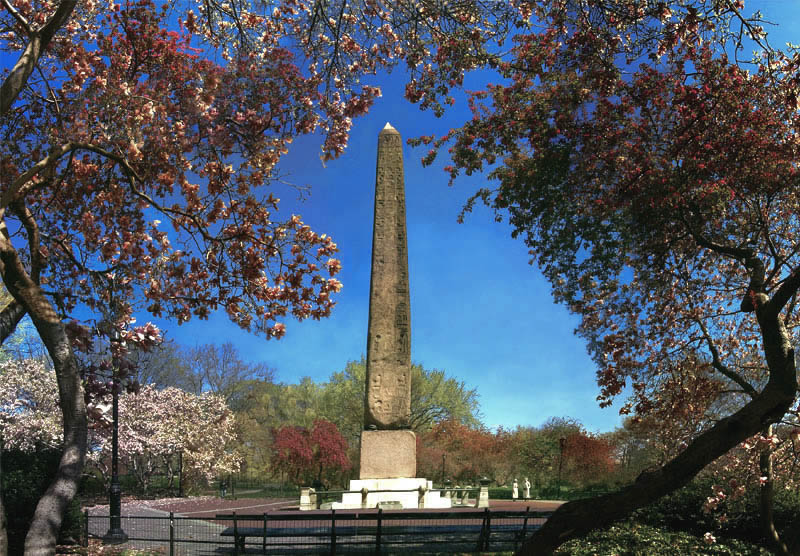𝗧𝗛𝗥𝗘𝗔𝗗. More intact obelisks stand in Rome than in the whole Egypt.
The Eternal City has eight ancient Egyptian and five Roman obelisks, some of which are over 3,000 years old!
The Eternal City has eight ancient Egyptian and five Roman obelisks, some of which are over 3,000 years old!
1. 𝗢𝗯𝗲𝗹𝗶𝘀𝗸 𝗶𝗻 𝗣𝗶𝗮𝘇𝘇𝗮 𝗦. 𝗣𝗶𝗲𝘁𝗿𝗼
Originally raised in the Forum Iulium in Alexandria, it was moved to Rome by Caligula who placed it in the Circus he had built in the Vatican. It’s the only obelisk in Rome that has not toppled since Roman times.
Originally raised in the Forum Iulium in Alexandria, it was moved to Rome by Caligula who placed it in the Circus he had built in the Vatican. It’s the only obelisk in Rome that has not toppled since Roman times.
2. 𝗢𝗯𝗲𝗹𝗶𝘀𝗸 𝗼𝗳 𝗣𝘀𝗮𝗺𝗺𝗲𝘁𝗶𝗰𝗵𝘂𝘀 𝗜𝗜 𝗶𝗻 𝗣𝗶𝗮𝘇𝘇𝗮 𝗱𝗶 𝗠𝗼𝗻𝘁𝗲𝗰𝗶𝘁𝗼𝗿𝗶𝗼
It was brought to Rome by Augustus who placed it as a sundial in a vast square, where its shadow indicated the hours of the day and the days of the year.
It was brought to Rome by Augustus who placed it as a sundial in a vast square, where its shadow indicated the hours of the day and the days of the year.
3. 𝗢𝗯𝗲𝗹𝗶𝘀𝗸 𝗼𝗳 𝗧𝗵𝘂𝘁𝗺𝗼𝘀𝗲 𝗜𝗩 𝗶𝗻 𝗦. 𝗚𝗶𝗼𝘃𝗮𝗻𝗻𝗶 𝗶𝗻 𝗟𝗮𝘁𝗲𝗿𝗮𝗻𝗼
As well as being the tallest Egyptian obelisk in the world, it may well also be the oldest (15 century BC). Placed in the Temple of Amun Re in Thebes it was moved to the Circus Maximus.
As well as being the tallest Egyptian obelisk in the world, it may well also be the oldest (15 century BC). Placed in the Temple of Amun Re in Thebes it was moved to the Circus Maximus.
4. 𝗢𝗯𝗲𝗹𝗶𝘀𝗸 𝗼𝗳 𝗥𝗮𝗺𝗲𝘀𝗲𝘀 𝗜𝗜 𝗶𝗻 𝗣𝗶𝗮𝘇𝘇𝗮 𝗱𝗲𝗹 𝗣𝗼𝗽𝗼𝗹𝗼
It was brought to Rome by Augustus after the death of Mark Antony and Cleopatra and erected at the centre of Circus Maximus, making this the first obelisk erected in Rome.
It was brought to Rome by Augustus after the death of Mark Antony and Cleopatra and erected at the centre of Circus Maximus, making this the first obelisk erected in Rome.
5. 𝗢𝗯𝗲𝗹𝗶𝘀𝗸 𝗮𝘁 𝘁𝗵𝗲 𝗘𝘀𝗾𝘂𝗶𝗹𝗶𝗻𝗼
One of “twin” obelisks, which once decorated the entrance of emperor Augustus mausoleum.
One of “twin” obelisks, which once decorated the entrance of emperor Augustus mausoleum.
6. 𝗢𝗯𝗲𝗹𝗶𝘀𝗸 𝗮𝘁 𝘁𝗵𝗲 𝗤𝘂𝗶𝗿𝗶𝗻𝗮𝗹𝗲
Twin of Piazza dell’Esquilino Obelisk. They don’t have any inscription in hieroglyphs.
Twin of Piazza dell’Esquilino Obelisk. They don’t have any inscription in hieroglyphs.
7. 𝗢𝗯𝗲𝗹𝗶𝘀𝗸 𝗼𝗳 𝗗𝗼𝗺𝗶𝘁𝗶𝗮𝗻 𝗶𝗻 𝗣𝗶𝗮𝘇𝘇𝗮 𝗡𝗮𝘃𝗼𝗻𝗮
Commissioned by Domitian and erected at the Temple of Serapis. It was later moved to the Circus of Maxentius. In 1649 it was erected on top of the Fountain of the Four Rivers designed by Gian Lorenzo Bernini
Commissioned by Domitian and erected at the Temple of Serapis. It was later moved to the Circus of Maxentius. In 1649 it was erected on top of the Fountain of the Four Rivers designed by Gian Lorenzo Bernini
8. 𝗢𝗯𝗲𝗹𝗶𝘀𝗸 𝗶𝗻 𝗣𝗶𝗮𝘇𝘇𝗮 𝗱𝗲𝗹𝗹𝗮 𝗥𝗼𝘁𝗼𝗻𝗱𝗮
This little obelisk was erected by Ramses II at the Temple of Ra, were it stayed for more than one thousand years. It was moved by emperor Domitian to the Temple of Isis.
This little obelisk was erected by Ramses II at the Temple of Ra, were it stayed for more than one thousand years. It was moved by emperor Domitian to the Temple of Isis.
9. 𝗠𝗶𝗻𝗲𝗿𝘃𝗮 𝗢𝗯𝗲𝗹𝗶𝘀𝗸
It was originally erected at Sais by Pharoah Apries. It was brought to Rome by emperor Diocletian for the Temple of Isis. In the mid-1600s, the obelisk was reassembled on top of an elephant by Bernini.
It was originally erected at Sais by Pharoah Apries. It was brought to Rome by emperor Diocletian for the Temple of Isis. In the mid-1600s, the obelisk was reassembled on top of an elephant by Bernini.
10. 𝗢𝗯𝗲𝗹𝗶𝘀𝗸 𝗶𝗻 𝗣𝗶𝗮𝘇𝘇𝗮 𝗱𝗶 𝗧𝗲𝗿𝗺𝗶𝗻𝗶
It was also originally erected in Heliopolis by Rameses II and moved to the Temple of Isis in Rome. In 1887 it became a little monument to the 500 Italians who had fallen at Dogali in Ethiopia.
It was also originally erected in Heliopolis by Rameses II and moved to the Temple of Isis in Rome. In 1887 it became a little monument to the 500 Italians who had fallen at Dogali in Ethiopia.
11. 𝗢𝗯𝗲𝗹𝗶𝘀𝗸 𝗮𝘁 𝗣𝗶𝗮𝘇𝘇𝗮 𝗱𝗲𝗹𝗹𝗮 𝗧𝗿𝗶𝗻𝗶𝘁𝗮̀ 𝗱𝗲𝗶 𝗠𝗼𝗻𝘁𝗶
It’s a smaller Roman copy of Ramses II Obelisk in Piazza del Popolo. The hieroglyphics were copied onto this obelisk. It was initially erected in a private residence called Horti Sallustiani
It’s a smaller Roman copy of Ramses II Obelisk in Piazza del Popolo. The hieroglyphics were copied onto this obelisk. It was initially erected in a private residence called Horti Sallustiani
12. 𝗢𝗯𝗲𝗹𝗶𝘀𝗸 𝗮𝘁 𝗣𝗶𝗮𝘇𝘇𝗮𝗹𝗲 𝗱𝗲𝗹 𝗣𝗶𝗻𝗰𝗶𝗼
Egyptian only in appearance, its construction was ordered by emperor Hadrian to memorialise the love of his life, Antinous. The obelisk was later moved by Elagabalus to decorate the spina of the Circus Varianus.
Egyptian only in appearance, its construction was ordered by emperor Hadrian to memorialise the love of his life, Antinous. The obelisk was later moved by Elagabalus to decorate the spina of the Circus Varianus.
13. 𝗢𝗯𝗲𝗹𝗶𝘀𝗸 𝗮𝘁 𝗩𝗶𝗹𝗹𝗮 𝗖𝗲𝗹𝗶𝗺𝗼𝗻𝘁𝗮𝗻𝗮
Originally, a companion to the Rotonda obelisk from the Temple of Ra in Heliopolis, is the smallest of the ancient Egyptian obelisks. It was also moved to the Temple of Isis.
Originally, a companion to the Rotonda obelisk from the Temple of Ra in Heliopolis, is the smallest of the ancient Egyptian obelisks. It was also moved to the Temple of Isis.
14. 𝗗𝗶𝗱 𝘆𝗼𝘂 𝗸𝗻𝗼𝘄 𝘁𝗵𝗲𝗿𝗲 𝘂𝘀𝗲𝗱 𝘁𝗼 𝗯𝗲 𝗮𝗻 𝗼𝗯𝗲𝗹𝗶𝘀𝗸 𝗼𝗻 𝗧𝗶𝗯𝗲𝗿 𝗜𝘀𝗹𝗮𝗻𝗱?
It was a 3rd century AC creation. The obelisk disappeared except for the top now in Palazzo Barberini’s gardens and two surviving fragments in Naples National Museum.
It was a 3rd century AC creation. The obelisk disappeared except for the top now in Palazzo Barberini’s gardens and two surviving fragments in Naples National Museum.
15. 𝗢𝗯𝗲𝗹𝗶𝘀𝗸 𝗼𝗳 𝗔𝘅𝘂𝗺
Erected in the 4th century AC, it was taken by Italy in 1937 following the invasion of Ethiopia. Returned by the Italian Republic in 2005 and re-erected in Axum in 2008.
Erected in the 4th century AC, it was taken by Italy in 1937 following the invasion of Ethiopia. Returned by the Italian Republic in 2005 and re-erected in Axum in 2008.
16. 𝗧𝘄𝗼 𝗼𝗯𝗲𝗹𝗶𝘀𝗸𝘀 𝗶𝗻 𝘁𝗵𝗲 𝗩𝗶𝗹𝗹𝗮 𝗧𝗼𝗿𝗹𝗼𝗻𝗶𝗮
In 19th century Rome, with original Egyptian obelisks being no longer "available", wealthy families had their own obelisks carved.
In 19th century Rome, with original Egyptian obelisks being no longer "available", wealthy families had their own obelisks carved.
17. 𝗠𝘂𝘀𝘀𝗼𝗹𝗶𝗻𝗶 𝗢𝗯𝗲𝗹𝗶𝘀𝗸
In fascist Italy (1922-45) obelisks are once again monuments loaded with propaganda value. This obelisk was build outside the Foro Italico to mark the 10th anniversary of the Fascist regime.
In fascist Italy (1922-45) obelisks are once again monuments loaded with propaganda value. This obelisk was build outside the Foro Italico to mark the 10th anniversary of the Fascist regime.
But Egyptian and Roman obelisks are not found only in Rome:
18. 𝗕𝗼𝗯𝗼𝗹𝗶 𝗼𝗯𝗲𝗹𝗶𝘀𝗸
Constructed in Heliopolis by Ramses II, it was transfered from Rome to Florence by the Grand Duke of Tuscany in the Boboli Gardens.
18. 𝗕𝗼𝗯𝗼𝗹𝗶 𝗼𝗯𝗲𝗹𝗶𝘀𝗸
Constructed in Heliopolis by Ramses II, it was transfered from Rome to Florence by the Grand Duke of Tuscany in the Boboli Gardens.
19. 𝗨𝗿𝗯𝗶𝗻𝗼 𝗼𝗯𝗲𝗹𝗶𝘀𝗸
This obelisk was raised originally in Sais, Egypt, around 580 B.C.. Initially placed in the Campus Martius in Rome, it was moved to Urbino in 1737 to celebrate Pope Clement XI.
This obelisk was raised originally in Sais, Egypt, around 580 B.C.. Initially placed in the Campus Martius in Rome, it was moved to Urbino in 1737 to celebrate Pope Clement XI.
20. 𝗟𝘂𝘅𝗼𝗿 𝗢𝗯𝗲𝗹𝗶𝘀𝗸 𝗶𝗻 𝘁𝗵𝗲 𝗣𝗹𝗮𝗰𝗲 𝗱𝗲 𝗹𝗮 𝗖𝗼𝗻𝗰𝗼𝗿𝗱𝗲, 𝗣𝗮𝗿𝗶𝘀
It dates back over 3,300 years and was originally one of a pair of obelisks that were positioned outside the Luxor temple in Egypt. Given to France in 1831 by the viceroy of Egypt.
It dates back over 3,300 years and was originally one of a pair of obelisks that were positioned outside the Luxor temple in Egypt. Given to France in 1831 by the viceroy of Egypt.
21. 𝗖𝗹𝗲𝗼𝗽𝗮𝘁𝗿𝗮'𝘀 𝗡𝗲𝗲𝗱𝗹𝗲 𝗶𝗻 𝗟𝗼𝗻𝗱𝗼𝗻
It was originally erected in the city of Heliopolis on the orders of Thutmose III, around 1450 BC. Given to the British government in 1819 to commemorate their victories over Napoleon in the battles fought in Egypt.
It was originally erected in the city of Heliopolis on the orders of Thutmose III, around 1450 BC. Given to the British government in 1819 to commemorate their victories over Napoleon in the battles fought in Egypt.
22. 𝗖𝗹𝗲𝗼𝗽𝗮𝘁𝗿𝗮'𝘀 𝗡𝗲𝗲𝗱𝗹𝗲 𝗶𝗻 𝗡𝗲𝘄 𝗬𝗼𝗿𝗸 𝗖𝗶𝘁𝘆
Also commissioned around 1450 BCE to commemorate Pharaoh Thutmose III's 30th year of reign. Given to encourage good trade relations between the US and Egypt after the opening of the Suez Canal.
Also commissioned around 1450 BCE to commemorate Pharaoh Thutmose III's 30th year of reign. Given to encourage good trade relations between the US and Egypt after the opening of the Suez Canal.

 Read on Twitter
Read on Twitter